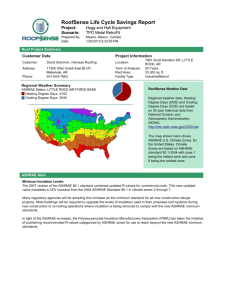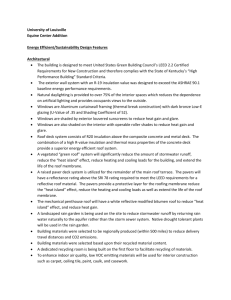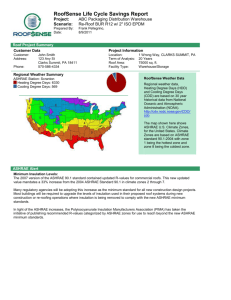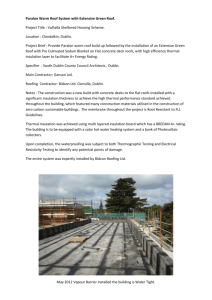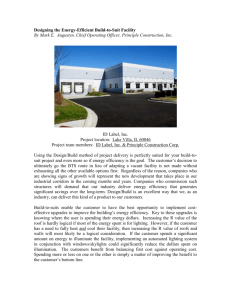RoofSense Life Cycle Savings Report
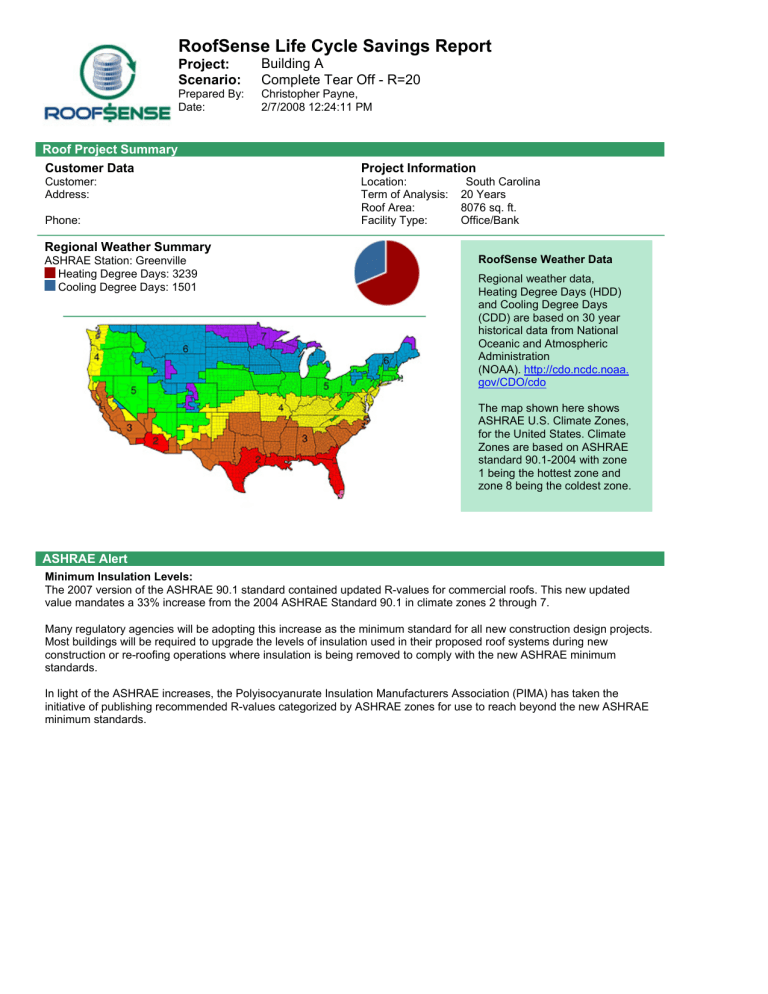
RoofSense Life Cycle Savings Report
Project:
Building A
Scenario:
Complete Tear Off - R=20
Prepared By: Christopher Payne,
Date: 2/7/2008 12:24:11 PM
Roof Project Summary
Customer Data
Customer:
Address:
Phone:
Regional Weather Summary
ASHRAE Station: Greenville
Heating Degree Days: 3239
Cooling Degree Days: 1501
Project Information
Location: South Carolina
Term of Analysis: 20 Years
Roof Area: 8076 sq. ft.
Facility Type: Office/Bank
RoofSense Weather Data
Regional weather data,
Heating Degree Days (HDD) and Cooling Degree Days
(CDD) are based on 30 year historical data from National
Oceanic and Atmospheric
Administration
(NOAA). http://cdo.ncdc.noaa.
gov/CDO/cdo
The map shown here shows
ASHRAE U.S. Climate Zones, for the United States. Climate
Zones are based on ASHRAE standard 90.1-2004 with zone
1 being the hottest zone and zone 8 being the coldest zone.
ASHRAE Alert
Minimum Insulation Levels:
The 2007 version of the ASHRAE 90.1 standard contained updated R-values for commercial roofs. This new updated value mandates a 33% increase from the 2004 ASHRAE Standard 90.1 in climate zones 2 through 7.
Many regulatory agencies will be adopting this increase as the minimum standard for all new construction design projects.
Most buildings will be required to upgrade the levels of insulation used in their proposed roof systems during new construction or re-roofing operations where insulation is being removed to comply with the new ASHRAE minimum standards. minimum standards.
In light of the ASHRAE increases, the Polyisocyanurate Insulation Manufacturers Association (PIMA) has taken the initiative of publishing recommended R-values categorized by ASHRAE zones for use to reach beyond the new ASHRAE
RoofSense Life Cycle Savings Report
Project:
Scenario:
Complete Tear Off - R=20
Prepared By: Christopher Payne,
Date: 2/7/2008 12:24:11 PM
Roof Details
Roof Assembly
The following items were included in the roof assembly structure as a part of the life cycle cost comparison. The R values are shown for each included component of the assembly. Components in the assembly are present in the baseline roof as well as the proposed roof.
Assembly Item
Outside Air
Membrane
Cover Board
Roof Insulation
Vapor Retarder
Base Board
Deck
Air Space
Batt Insulation
Ceiling Tile
Inside Air
R Value
0.17
0.33
0
0
0
0
0
0.94
0
1.5
0.61
What is R-Value?
R-Value is a measure of apparent thermal conductivity, and thus describes the rate that heat energy is transferred through a material or assembly item, regardless of the heat source.
Higher R Value indicates a higher resistance to heat transfer.
R values provided are from manufacturer specification or provided as scientific constants unless otherwise noted.
Total Assembly R: 3.55
Roof Membrane and Insulation:
The following section details the roof membrane and insulation for the baseline and proposed roof systems being observed in the life cycle cost comparison.
1/2" Rec. Bd. & .045 TPO
Roof Surface Type:
Proposed Roof B:
R-20 Iso & .060 TPO
TPO White
Existing Assembly Insulation R: 0
Insulation R to be Added: 1.4
Layer 1: n/a
Layer 2: n/a
Total Insulation R: 1.4
Roof Surface Type:
TPO White
Existing Assembly Insulation R: 0
Insulation R to be Added: 20.5
Layer 1: 3.3 inches of Polyiso
Layer 2: n/a
Total Insulation R: 20.5
RoofSense Life Cycle Savings Report
Project:
Scenario:
Complete Tear Off - R=20
Prepared By: Christopher Payne,
Date: 2/7/2008 12:24:11 PM
Energy Cost Summary
Heating and Cooling Data:
The heating and cooling load is referred to as the cost to heat and cool the facility. Following are the details of the buildings system efficiency, fuel type and associated cost used in the energy load calculation.
Cooling Data
Fuel Type: Electricity Fuel Type: Natural Gas
System Efficiency: 8 S.E.E.R or E.E.R
Fuel Cost: $0.0739 /Kwh
Fuel Inflation Rate: 3.11% per yr
System Efficiency: 65%
Fuel Cost: $11.97 /1000 CF
Fuel Inflation Rate: 8.76% per yr
Estimated Energy Cost:
The energy model within RoofSense compares the estimated energy cost of two roof systems over the term of analysis.
Fuel cost and inflation, interior temperature, climate, roof surface type and color, and the amount of insulation utilized are included in the energy cost formulas. The following are estimated energy costs.
1/2" Rec. Bd. & .045 TPO
Estimated Energy Cost:
R-20 Iso & .060 TPO
Estimated Energy Cost:
Cooling: $22,480.52 Cooling: $4,626.97
Heating: $130,902.19 Heating: $26,942.45
Total: $153,382.71 Total: $31,569.41
Environmental Emissions: Environmental Emissions:
CO2 Carbon Dioxide 626.92 Tons
CH4 Methane 13.75 LBS
NOx Nitrogen Oxides 21.9 LBS
CO2 Carbon Dioxide 129.03 Tons
CH4 Methane 2.83 LBS
NOx Nitrogen Oxides 4.51 LBS
Energy Cost Savings
Savings is equivalent to:
$121,813.30 less dollars
79.42%
1992
Trees planted
Carbon Reduction:
761994
Airplane miles
497.9 less tons
79.42%
100
Less cars on road
Energy Savings Notes:
The RoofSense energy savings model is based on the LC4 Life Cycle cost analysis tool developed by Pat Downey of Merik Professional Roofing Services in the late 1990's. The LC4 energy calculations and formulas are taken from the "1989 ASHRAE Fundamentals Handbook". Also used was the "Guide for
Estimating Difference in Building Heating and Cooling Energy due to Change in Solar Reflectance of a Low-Slopped Roof", Oak Ridge National Laboratory publication ORNL-6527 and the "NRCA Energy Manual" third edition, National Roofing Contractors Association, Chicago, IL. Adjustments to the formula and reflectance have been made as a result of a benchmarking study completed using Carrier's "Hourly Analysis Program" (HAP) and ASHRAE's standards on building simulation. Carrier's HAP is approved by the government for studies done for the Tax Policy Act of 2005. Historic energy cost data, when used, has been obtained from the Energy Information Agency (EIA) www.eia.doe.gov
.
RoofSense Life Cycle Savings Report
Project: Building A
Scenario: Complete Tear Off - R=20
Prepared By: Christopher Payne,
Date: 2/7/2008 12:24:11 PM
Life Cycle Cost Summary
Life Cycle Cost Overview:
A Life Cycle cost analysis is an important part of the decision process in determining the best alternative in a roofing decision. The energy costs of heating and cooling a structure is often the largest of the "hidden costs" associated with the selection of any roofing system.
Typically, when decisions are based on low initial costs, there is a resulting increase in operating costs. Increased energy costs, maintenance costs, and a shorter operating life can result. When decisions are based on increasing the quality of performance of the roof system, significant benefits can be achieved in operating cost reductions. RoofSense allows you to consider the Total Cost of Ownership for competing roof systems.
Total Life Cycle Cost Comparison:
Considering the provided installation cost as well as the operating costs over the term of analysis, a Total Life Cycle Cost can be calculated for each roof system. The following summary shows a comparison of these costs.
1/2" Rec. Bd. & .045 TPO
Estimated Operating Costs:
Heating:
Cooling:
Maintenance:
$130,902.19
$22,480.52
$40,380.00
$193,762.71
Depreciated Installed Costs:
Installation:
Depreciation:
Est. Tax Credit:
$22,209.00
($12,300.37)
($1,776.72)
$8,131.91
Total Life Cycle Cost:
$201,894.62
$25.00 /sq ft
R-20 Iso & .060 TPO
Estimated Operating Costs:
Heating:
Cooling:
Maintenance:
$26,942.45
$4,626.97
$8,076.00
$39,645.41
Depreciated Installed Costs:
Installation:
Depreciation:
Est. Tax Credit:
$39,007.08
($21,603.92)
($3,120.57)
$14,282.59
Total Life Cycle Cost:
$53,928.01
$6.68 /sq ft
Est. Operating Cost Savings:
Depreciated Installed Cost Difference:
Est. Life Cycle Cost Savings:
Return on Investment:
$154,117.30
($6,150.68)
$147,966.61
31.6%
